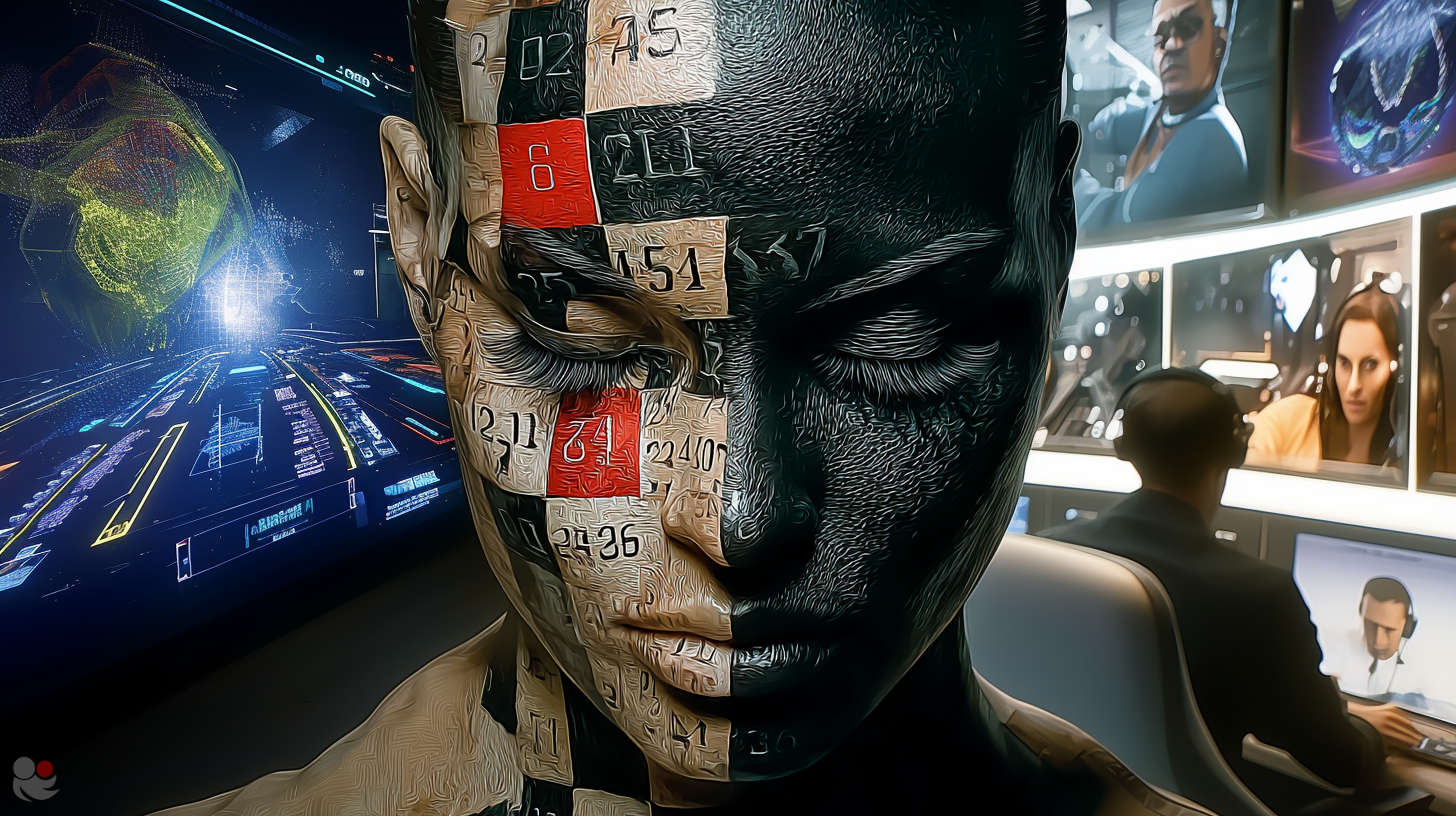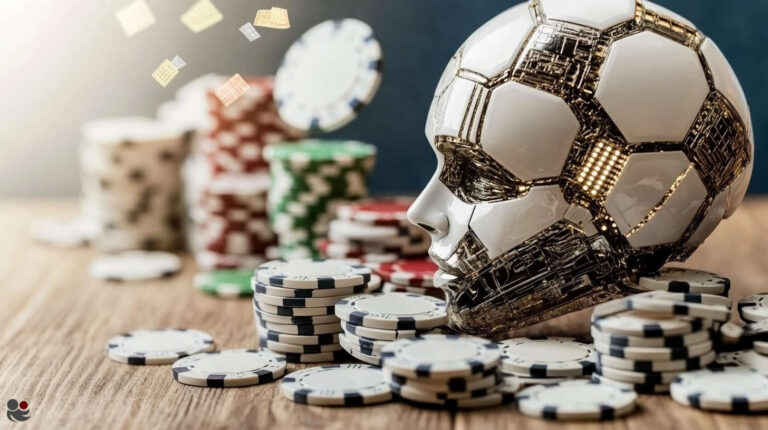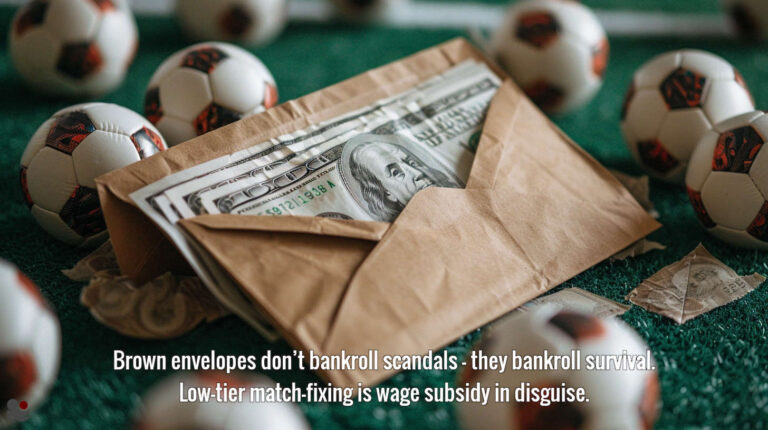
AI doesn’t predict the match. It predicts your emotions.
🧠 The Non-Neutrality of Odds
From “flash odds” in adverts to AI-driven real-time pricing, every number you see is calculated not just from the pitch, but from how the public – you – is expected to behave.
The old belief that odds “reflect likelihood” is a myth. They reflect market psychology, risk management, and strategic nudging.
If you want to survive modern betting, understand this:
YOU’RE BETTING IN A SYSTEM THAT’S BETTING ON YOU.
⏰ In-Play Odds are Crafted for Urgency, not Fairness
🎭 The Betting Environment Uses Odds Tactically, not Neutrally
🏗️ The Market Architecture: Odds Dynamically Adapt to Demand
🗣️ Lived Evidence: Punters See the System Watching
🎯 Can a Regular Punter Beat This System?
📚 Further Reading: Evidence of Non-Neutral Odds
Most people believe odds reflect the probability (likelihood) of an outcome.
But if you’ve ever placed a bet in-play while live-streaming a match, you’ve seen the odds flicker and shift – nudging you, rushing you.
You hesitate, and they change. You act quickly, and later wonder if the decision was truly yours.
This article exposes how in-play odds aren’t neutral reflections of probability – they’re dynamic, bias-driven tools, crafted to influence and extract your money from you.
💡 What Does ‘Non-Neutrality’ Mean? ⤴️
Let’s begin with the original economic meaning of non-neutrality.
In macroeconomics, non-neutrality of money means that changes in the supply or flow of money have real effects on the economy: Influencing investment, employment, and other market behaviour.
In sports betting, odds are the money language of the market. And like money, odds are not neutral.
For example, according to Karl Whelan [1], the favourite-longshot bias in betting markets illustrates non-neutrality perfectly:
Odds don’t accurately reflect true probabilities – they reflect bookmakers’ risk aversion, managing exposure and shaping bettor responses.
Money – and odds, as prices for bets – are MARKET INSTRUMENTS.
They are not just used for a neutral exchange of goods or bets.
They are – like interest rates or central bank interventions – deployed tactically: To steer decision-making, reshape systems, and produce economic effects.
Both money and odds have power beyond their face value. They are not static figures.
They are dynamic forces – tools of influence, not just markers of value.
The core insight: Odds and money don’t just measure the world.
They act on it.
Let’s explore what that looks like in practice.
⏰ In-Play Odds are Crafted for Urgency, not Fairness ⤴️
There is a peer-reviewed study about World Cup ads: Live-Odds Advertising in the 2018 World Cup. Researchers analysed the live-odds adverts broadcast during the FIFA World Cup in the UK.
A call to action (CTA) is a marketing term for anything designed to prompt an immediate response or encourage an immediate sale. A CTA is a piece of content intended to induce a viewer, reader, or listener to perform a specific act – typically taking the form of an instruction or directive (e.g. buy now or click here).
The study exposes the framing of odds as behavioural tools. [2]
- Most live-odds ads promoted time-sensitive, high-margin bets – such as correct score in 20 minutes.
- These odds weren’t just shown; they were designed to provoke action.
- They offered poor value and demanded immediate action.
This was a non-neutral mechanism in action:
Odds were chosen and pushed strategically, not randomly. The bookmakers selected which markets and prices to advertise, knowing they would alter the bettor’s psychology.
Thus, odds became psychological triggers. Their placement on screen, their time-limited nature, their framing as special offers – all designed to make punters react and part with their money.
If you don’t understand conditional probabilities, you’re the one being played.
Here’s how In-Play odds manipulate more than they reveal.
🎭 The Betting Environment Uses Odds Tactically, not Neutrally ⤴️
If you think this World Cup example was just a one-off, here’s something else worth reading… An article about Dark nudges in gambling [3] shows that odds are part of an interface that shapes crowd dynamics.
Platforms use “dark nudges” – urgency, friction reduction, visual cues – to guide punter choices. Odds and bet prompts are part of that ecosystem.
Odds are presented in ways that nudge you toward action.
- Punters respond to how odds look and feel, not just what they mean.
- Odds shown on adverts are rarely showing the true probabilities.
- They are the ones you’re most likely to chase.
And you must believe us, this is not just in advertising. Odds manipulation in favour of the bookmakers runs through the entire live betting ecosystem.
Learn to see it. Start noticing!
Now they predict you – when you’ll click, cash out, panic, or chase.
In-Play Odds don’t reflect the match. They reflect the market on the match.
🏗️ The Market Architecture: Odds Dynamically Adapt to Demand ⤴️

We found an article worthwhile mentioning, by an Insider:
“I was a bookie once. About a decade ago. I remember the days when setting football odds was more like an art. A mix of gut feeling, basic stats, and local know-how.” [4]
That’s how Michal Mikulasi opened his piece on the evolution of bookmaker systems. His article is one of the rare accounts from someone who has seen both sides: the manual past and the algorithmic present.
Michal explains that odds are no longer set to reflect what might happen on the pitch. They are set to reflect what is happening in the market – in real time.
That market includes:
- The volume of money moving on each outcome
- The types of bets being placed (e.g. next goal vs full-time result)
- The biases of punters known to the system (e.g. cautious vs impulsive)
- And yes, still some match data – but as one factor among many
This is a fundamental shift in logic.
🤖 Market Algorithms: AI-Based Pricing
The modern odds system ingests vast quantities of live data:
- Player and ball movements
- Weather forecasts and changes
- Social media sentiment
- Maybe even changes in crowd noise
Let’s say a popular influencer tweets, “Looks like a cagey game – I’m going for under 2.5 goals.”
Within seconds, bets start flooding in. The system sees this, not as noise, but as signal.
At this moment, AI will be calculating ripple effects across hundreds of Odds (price points) – and doing so before you even nip your coffee.
Not because the match has changed – but because demand has, within a few seconds.
Machine learning models dynamically adjust not just one market… they recalculate every sub-market in parallel, minute-by-minute:
- Full-Time Market
- Next goal scorer
- Over/Under 2.5 goals
- Both teams to score (BTTS)
- Number of corners or cards
- Dozens of other things as well
Odds don’t just reflect reality. They reflect how the system is defending itself.
Every bet you (and other punters) place feeds the system more data on how to shape the market next.
The trick is not to beat you on one bet. It’s to guide your whole activity.
👉 How do Bookmakers Tick? How & Why do they Set Their Odds as they do?
🗣️ Lived Evidence: Punters See the System Watching ⤴️

The following quotes provide “insider” details – about traders, simulations, derived markets.
“They’re not predicting the game. They’re predicting what people are willing to bet on the game. And they have all the information on what people normally bet on certain types of games. …
And then if people are betting differently, the “line moves,” meaning new bets are taken at odds reflecting the mass market of bettors.”
– user ilaidonedown
“In-game betting. These are pretty much ‘solved’ now for major sports, where the impact of (say) a touchdown in the 14th minute or an individual player being sent off has been calculated and automatically updates. …”
– user soberkangaroo
“Yes. Everyone else here spouting that books want even money on both sides is confidently WRONG.
If that was the only consideration, sharp bettors would end up cleaning out books with bets just before the game starts.”
The myth that bookmakers “just want even money on both sides” falls apart here. That old balancing act has been replaced by something far more agile – and far more asymmetric.
In-Play odds aren’t designed for fairness. They manage liability, shape emotion, and recalibrate risk in real time.
Even a 50/50 event like a coin toss becomes skewed the moment odds shift.
This is where value begins – in the gap between price and probability.
Learn how value is created (or lost) in every bet you place.
Every second. Every click. Every bet. It all shapes the next price you see.
🎯 Can a Regular Punter Beat This System? ⤴️
To even stand a chance, you’d need:
- A profound, working command of probability and risk
- High-quality, real-time data feeds (not tipster screenshots)
- Machine learning fluency (Python, TensorFlow, Bayesian logic)
- A bulletproof bankroll strategy and psychological discipline
In short: not football knowledge – but tools, infrastructure, and cold logic.
The HDAFU Tables uncover the long-term patterns hidden behind the 1X2 prices,
giving you a clarity you won’t find anywhere else.
Explore the tool that reveals how 1×2 odds really work.
🧠 ALWAYS REMEMBER: Odds are Non Neutral!
Once you realise odds are not neutral – that they’re shaped to shape you – you will start seeing betting from a completely different perspective. They will no longer look like a scoreboard, but more like a script.
And scripts can be analysed. Understood. Turned in your favour.
Think like a bookmaker, and the patterns start to reveal themselves:
-
Watch how odds move – not just what they are.
A sudden drift or drop mid-match isn’t always about the pitch. It’s often the crowd. You’re watching herd psychology priced in real time.
-
Avoid urgency triggers.
When you see “Next Goal Odds” flash up after a missed chance, that’s not value. That’s bait. Step back. Wait.
-
Test your emotional state before placing any In-Play bet.
Are you calm? Or are you reacting? If the market is moving and you feel it in your body – that’s manipulation working.
-
Log your own bets and the odds movement around them.
Over 20-30 matches, you’ll see a pattern in when you tend to bet – and what the market does just before. That’s your edge leaking.
-
Use tools that let you simulate your decision-making.
Odds calculators, bet diaries, even dummy betting rounds. Train yourself to spot manipulation before you feel it.
The main lesson to remember is this:
And always remember: Knowledge is Power.
The more you understand how odds are made, the more you stay in control – calm, confident, and ready to enjoy the game on your own terms.
📣 Before You Go…
So then, after everything you’ve just read about ML, shifting odds, and demand-driven optimised pricing…
Do you still think there’s a real chance of beating the bookie?
Or has this made you look, especially at In‑Play, a bit differently?
Feel free to share your thoughts in the comments. You’re likely not alone in wondering!
📚 Further Reading: Evidence of Non-Neutral Odds ⤴️
[1] Karl Whelan – Risk Aversion and the Favourite-Longshot Bias (2023)
[2] Philip Newall et al. – Live-Odds Gambling Advertising and Consumer Protection (2019)
[3] Philip W. S. Newall – Dark Nudges in Gambling (2018)
[4] Michal Mikuláš – Odds: How Bookmakers Use AI to Stay Ahead (2025)
[5] Reddit /r/ExplainLikeImFive – How Are Sportsbooks So Accurate? (2024)
Prices would move, but the real system – how much people bet, how they bet, what they feel – would stay unchanged.
But odds are non-neutral:
- A drift or a flash boost doesn’t just alter the nominal price, it changes demand.
- Punters stake more, cash out faster, chase losses differently.
- The behavioural economy of betting is reshaped by every odds tweak.
So odds are not a passive reflection of probability – they intervene in the system, just as money supply interventions do in an economy.
This article introduces the first ‘official’ definition of non-neutrality of odds:
Beyond “odds = implied probability,” they operate as market instruments –
designed to influence bettor’s decision-making, not merely manage bookmaker’s risk.








Hello,
I am using your method and I have created my strategies, but I would like to get forward in developing strategies for new leages, what are not listed in footballdata.co.uk-s database.
I would appreciate if you could help me with downloadable data for other countries/leagues, for ex. Champions LEague, World Cup, etc.
Thanks!
Hi Szabolcs,
here are a few websites that offer free football data downloads besides football-data.co.uk:
1. openfootball.github.io
2. publicapi.dev/open-liga-db-api
3. rsssf.org
However, none of them is as straightforward or as easy to download from as Football-Data.
If you’d like to extract data in CSV format from these sources, I’d recommend opening an AI chatbot of your choice – ChatGPT, Gemini or DeepSeek – and asking for step-by-step assistance.
Good luck!
And if you happen to find something especially useful, I’d love to hear from you again. 🙂